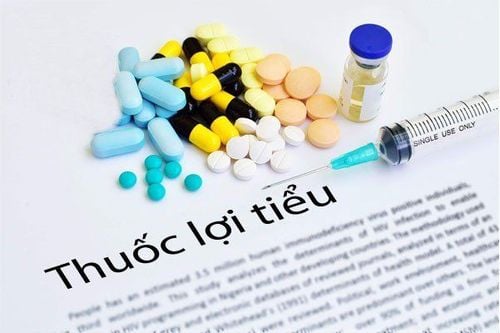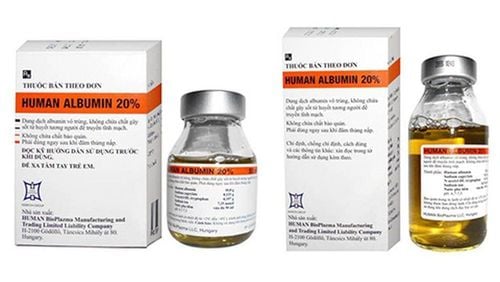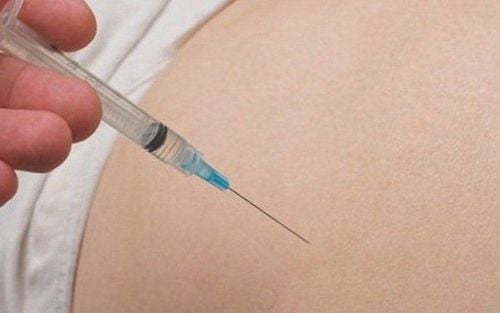This is an automatically translated article.
Cefuroxime is an antibiotic belonging to the cephalosporin group. This drug is used in the treatment of bacterial infections such as respiratory infections, gastrointestinal infections. What is Cefuroxime? What is Cefuroxime used for? The following article will help you better understand the uses of Cefuroxime and the notes when using Cefuroxime.1. What are the uses of Cefuroxime?
1.1. What is Cefuroxime? Cefuroxime is a second generation cephalosporin antibiotic. Cefuroxime drug has many different dosage forms such as:
Cefuroxime axetil: With oral form, dosage and content are expressed in terms of Cefuroxime: Oral suspension form: Content 125 mg/5 ml and 250 mg/5 ml. Tablet form: 125 mg, 250 mg and 500 mg. Cefuroxime sodium: For injection form, dosage and content are expressed in terms of cefuroxime: Vial of powder for injection with content of 250 mg, 750 mg or 1.5g. Cefuroxime is recommended for use in children and adults but requires a prescription.
1.2. What is Cefuroxime used for? Cefuroxime is a 2nd generation, semi-synthetic, cephalosporin antibiotic that kills bacteria in the growth and division stages by inhibiting bacterial cell wall synthesis.
Cefuroxime is prescribed in the following cases:
Oral Cefuroxime axetil Treatment of mild to moderate infections of the respiratory tract caused by susceptible bacteria: otitis media, recurrent sinusitis, tonsillitis, recurrent pharyngitis, exacerbation of chronic bronchitis or acute bronchitis with superinfection, community-acquired pneumonia. Treatment of uncomplicated gonorrhea, early Lyme disease. Cefuroxime sodium injection Treatment of severe lower respiratory tract infections (including pneumonia), skin and soft tissue infections, bone and joint infections, severe urinary-genital infections, bacteremia, and meningitis brain caused by susceptible bacteria. Prophylactic treatment of infections in cardiovascular and other thoracic surgery, orthopedic surgery, gastrointestinal surgery and obstetric and gynecological surgery.
2. Usage of Cefuroxime
2.1. Cách dùng thuốc Cefuroxime Đường uống: Cefuroxime đường uống có thể ở dạng thuốc viên hay hỗn dịch. Thuốc nên được dùng trong bữa ăn để tăng sinh khả dụng. Đối với trẻ em từ 3 tháng đến 12 tuổi không có khả năng nuốt được viên nén, nên dùng dạng bột pha hỗn dịch thay vì nghiền viên nén và trộn lẫn với thức ăn, hoa quả. Bột pha hỗn dịch nên được pha ngay trước khi sử dụng bằng cách thêm nước vừa đủ (theo hướng dẫn của nhà sản xuất) vào chai để được hỗn dịch có chứa 125mg hoặc 250mg cefuroxime trong 5 ml. Hỗn dịch cần được lắc đều trước mỗi lần sử dụng và lọ đựng cần được đậy kín lại sau mỗi lần lấy thuốc. Thuốc được hấp thu tốt nhất khi uống trong bữa ăn. Đường tiêm: Cefuroxime natri có thể dùng đường tiêm bắp, tiêm tĩnh mạch trực tiếp, truyền tĩnh mạch ngắt quãng và tiêm truyền tĩnh mạch liên tục. Tiêm bắp : Hòa bột pha tiêm Cefuroxime natri trong lọ bằng một lượng nước cất vô trùng để đạt nồng độ 220 mg/ml. Hỗn dịch này cần được lắc đều trước khi tiêm. Tiêm bắp sâu vào vùng cơ lớn như mông hoặc mặt trong của đùi. Tiêm tĩnh mạch trực tiếp: Hòa bột pha tiêm bằng 8ml hoặc 16 ml nước cất pha tiêm tương ứng với lọ bột chứa 750 mg và 1,5 g Cefuroxime natri. Dung dịch này có thể tiêm chậm trực tiếp vào tĩnh mạch hoặc vào dây truyền dịch có chứa dịch truyền tương hợp trong thời gian ít nhất là 5 phút. Truyền tĩnh mạch ngắt quãng và truyền tĩnh mạch liên tục: Có thể dùng 100 ml nước cất pha tiêm hoặc dung dịch Dextrose 5% hoặc dung dịch Natri clorid 0,9% để thêm vào túi truyền dịch có chứa 750 mg hoặc 1,5 g Cefuroxime natri hoặc chuyển dung dịch hòa tan bột pha tiêm Cefuroxime vào các chai truyền thủy tinh hoặc nhựa PVC có chứa dung môi tương hợp. Truyền tĩnh mạch ngắt quãng thường kéo dài trong khoảng thời gian từ 15 phút đến 60 phút. 2.2. Liều dùng của thuốc Cefuroxime 2.2.1. Người lớn:
Nhiễm khuẩn tai mũi họng (viêm họng, viêm tai giữa, viêm xoang): Uống 250 mg hoặc 500 mg, 12 giờ một lần. Thời gian điều trị 10 ngày. Nhiễm khuẩn hô hấp dưới: Đợt cấp của viêm phế quản mạn tính: Uống 250 mg hoặc 500 mg, 12 giờ một lần trong 10 ngày. Viêm phế quản cấp tính có kèm bội nhiễm: Uống 250 mg hoặc 500 mg, 12 giờ một lần trong 5 - 10 ngày. Viêm phổi cộng đồng cho bệnh nhân ngoại trú: Uống 500 mg, 12 giờ một lần trong 10 - 14 ngày. Viêm bàng quang : Nếu bạn không có biến chứng nào, uống Cefuroxime 250mg hai lần một ngày hoặc dùng tiêm bắp liều 750mg hoặc tiêm tĩnh mạch cách 8 giờ 1 lần trong 7 đến 10 ngày. Viêm nắp thanh quản: Dùng Cefuroxime hàm lượng 1,5g tiêm tĩnh mạch cách 6 đến 8 giờ 1 lần trong 7 - 10 ngày, tùy thuộc vào tính chất bệnh và mức độ nhiễm trùng. Nhiễm trùng khớp: Dùng Cefuroxime hàm lượng 1,5g tiêm tĩnh mạch cách 8 giờ 1 lần và điều trị liên tục trong khoảng 3 đến 4 tuần, tuỳ thuộc vào tính chất bệnh và mức độ của nhiễm trùng. Nếu bạn dùng thuốc Cefuroxime để điều trị nhiễm trùng khớp chân giả, tay giả, thời gian điều trị có thể lên đến 6 tuần hoặc hơn. Bệnh Lyme : Dùng Cefuroxime hàm lượng 500mg uống 2 lần một ngày liên tục trong 20 ngày; Viêm màng não: Dùng Cefuroxime 1,5g tiêm tĩnh mạch mỗi 6 giờ hoặc 3g mỗi 8 giờ trong 14 ngày. Viêm xương tủy: Dùng Cefuroxime 1,5g tiêm tĩnh mạch mỗi 8 giờ và điều trị liên tục trong khoảng 4-6 tuần tùy theo tính chất mức độ nhiễm trùng. Trường hợp bị viêm tủy xương mãn tính, bạn có thể điều trị uống kháng sinh thêm một đến hai tháng. Viêm phúc mạc : Dùng Cefuroxime 750mg đến 1,5g tiêm tĩnh mạch mỗi 8 giờ trong 10 - 14 ngày; Nếu bạn viêm phúc mạc liên quan đến viêm phổi cộng đồng, dùng 1g cho mỗi 2 lít thẩm tách màng bụng, theo sau là một liều duy trì liên tục 150 - 400mg mỗi 2 lít thẩm tách. Viêm phổi: Nếu bệnh của bạn không biến chứng, dùng Cefuroxime 750mg tiêm bắp hoặc tiêm tĩnh mạch mỗi 8 giờ; Nếu bệnh của bạn phức tạp, dùng 1,5g tiêm bắp hoặc tiêm tĩnh mạch mỗi 8 giờ. Khi bệnh nhân có phản ứng lâm sàng khi tiêm, dùng Cefuroxime 250-500mg mỗi 8 giờ trong 7 đến 21 ngày. Thời gian điều trị phụ thuộc vào độ nhạy cảm của vật nghi gây bệnh với Cefuroxime.
Viêm bể thận: Dùng Cefuroxime 750mg đến 1,5g uống mỗi 8 giờ hoặc 250 - 500mg, 2 lần một ngày trong 14 ngày, tùy thuộc vào tính chất, mức độ nhiễm trùng. Nhiễm khuẩn huyết : Dùng 1,5g tiêm tĩnh mạch mỗi 6 - 8 giờ, kết hợp với aminoglycosid; Điều trị liên tục trong 7 - 21 ngày tùy theo tính chất mức độ nhiễm trùng. Nhiễm trùng da hoặc mô mềm: Dùng Cefuroxime 250-500mg uống 2 lần một ngày (không biến chứng nhiễm trùng) hoặc dùng 750mg tiêm tĩnh mạch mỗi 8 giờ trong 10 ngày. Nhiễm khuẩn đường tiết niệu : Nếu bệnh của bạn không biến chứng, dùng Cefuroxime 250mg uống hai lần một ngày trong 7 - 10 ngày hoặc dùng 750mg tiêm tĩnh mạch mỗi 8 giờ. Nếu bệnh của bạn phức tạp, dùng 1,5g tiêm tĩnh mạch mỗi 8 giờ. Bệnh lậu cổ tử cung hoặc niệu đạo hoặc trực tràng không có biến chứng: Tiêm 1 liều duy nhất 1g Cefuroxime natri. Bệnh Lyme mới mắc: Uống 500 mg, 12 giờ một lần, trong 20 ngày. Kháng sinh dự phòng trong phẫu thuật: Phẫu thuật thông thường: Liều duy nhất 1,5g tiêm tĩnh mạch trong vòng 1 giờ trước phẫu thuật. Phẫu thuật mổ tim hở : Liều 1,5g tiêm tĩnh mạch lúc khởi mê, sau đó cứ 12 giờ lặp lại 1 lần cho đến khi đạt tổng liều 6 g. Phẫu thuật sạch - nhiễm và phẫu thuật nhiễm: Liều 1,5g tiêm tĩnh mạch ngay trước phẫu thuật (trong vòng 30 - 60 phút trước khi rạch da) và nếu phẫu thuật kéo dài thì sau mỗi 8 giờ thêm 750mg Cefuroxime natri tiêm tĩnh mạch hoặc tiêm bắp. 2.2.2. Trẻ em :
Thời gian điều trị trung bình: 10 ngày.
Đường uống (cefuroxime axetil): Trẻ 3 tháng - 2 tuổi: 10 mg/kg/lần (tối đa 125mg/lần), 12 giờ một lần. Trẻ 2 - 12 tuổi: 15 mg/kg/lần (tối đa 250mg/lần), 12 giờ một lần. Trẻ 12 - 18 tuổi: 250mg/lần, 12 giờ một lần. Có thể tăng gấp đôi trong trường hợp nhiễm khuẩn hô hấp dưới nặng hoặc khi nghi ngờ viêm phổi hoặc có thể giảm xuống 125mg/lần, 12 giờ một lần trong trường hợp nhiễm trùng tiết niệu dưới.
Đường tiêm tĩnh mạch, tiêm truyền tĩnh mạch hoặc tiêm bắp (Cefuroxime natri): Trẻ sơ sinh < 7 ngày tuổi: 25 mg/kg/lần, 12 giờ một lần. Trẻ sơ sinh 7 - 21 ngày tuổi: 25 mg/kg/lần, 8 giờ một lần. Trẻ sơ sinh 21 - 28 ngày tuổi: 25 mg/kg/lần, 6 giờ một lần. Trẻ 1 tháng tuổi - 18 tuổi: 20 mg/kg/lần (tối đa 750mg/lần), 8 giờ một lần. Điều trị bệnh Lyme: Trẻ 12 - 18 tuổi: Uống 500 mg, 12 giờ một lần trong 20 ngày. Kháng sinh dự phòng phẫu thuật: Trẻ 1 tháng tuổi - 18 tuổi: 50 mg/kg (tối đa 1,5 g) tiêm tĩnh mạch lúc khởi mê, sau đó có thể tiêm tĩnh mạch hoặc tiêm bắp tiếp đến 3 liều 30 mg/kg/lần (tối đa 750mg), 8 giờ một lần cho các phẫu thuật có nguy cơ nhiễm khuẩn cao. 2.2.3. Đối tượng khác:
Bệnh nhân bị suy thận:
Cefuroxime dùng đường tiêm: Không cần giảm liều điều trị cho các bệnh nhân có độ thanh thải creatinin (CrCl) > 20 ml/phút. Nhưng với bệnh nhân có độ thanh thải CrCl < 20 ml/phút, thì cần giảm liều dùng một lần hoặc tăng khoảng thời gian giữa 2 lần dùng thuốc, cụ thể như: Với người lớn: CrCl trong khoảng 10 - 20ml/phút: Liều 750mg, cách 12 giờ một lần. CrCl < 10 ml/phút: Liều 750mg, cách 24 giờ một lần. Thẩm tách máu: liều 750mg sử dụng cuối mỗi lần thẩm tách. Với trẻ em: Tăng khoảng cách thời gian giữa 2 lần dùng thuốc giống như ở người lớn. Cefuroxime dùng đường uống, nếu độ thanh thải creatinin CrCl < 20 ml/phút: Giảm nửa liều với khoảng cách thời gian giữa 2 lần dùng thuốc là 24 giờ. Xử lý khi quên liều:
Cố gắng không quên liều để đạt được hiệu quả điều trị tối ưu nhất. Nếu quên dùng một liều thuốc, hãy dùng ngay khi nhớ ra càng sớm càng tốt. Tuy nhiên, nếu gần với liều kế tiếp, hãy bỏ qua liều đã quên và dùng liều kế tiếp vào thời điểm như kế hoạch. Không dùng gấp đôi liều đã quy định.
Xử trí khi quá liều:
Triệu chứng quá liều: Buồn nôn, nôn, tiêu chảy, tăng kích thích thần kinh cơ và cơn co giật , nhất là ở người suy thận. Bảo vệ đường hô hấp của người bệnh, hỗ trợ thông thoáng khí và truyền dịch. Nếu có các cơn co giật, ngừng ngay thuốc, dùng liệu pháp chống co giật nếu cần.
3. Contraindications of the drug Cefuroxime
Patients who are allergic or have a history of allergy to drugs or antibiotics of the cephalosporin group. The body is sensitive to some antibiotics of the betalactam group (carbapenems, penicillins). Not recommended for children under 3 months of age. People with kidney disease: It is necessary to inform the doctor when suffering from a number of diseases: Kidney failure, kidney stones, glomerulonephritis, ... to change other drugs or adjust the dose to be safer. Pregnant women: The drug has not been identified as a risk to the fetus. However, pregnant women should not arbitrarily use the drug without the prescription of the obstetrician. Breastfeeding women: When entering the body, the drug will move to the milk glands, leading to unwanted side effects. Elderly people: It is easy to affect kidney function, reducing the drug elimination process, so they often experience more side effects than other subjects.
4. Precautions when taking Cefuroxime
Take a careful history of drug allergy, especially to beta-lactam antibiotics, before taking Cefuroxime. Hypersensitivity reactions with a variety of manifestations: Fever, pruritus, erythema, urticaria, Stevens-Johnson syndrome, toxic epidermal necrolysis, serum sickness-like reactions, anaphylactic reactions may occur. out (rate < 1%). The drug is only effective and highly effective in the treatment of bacterial infections. Do not use in the treatment of diseases caused by viruses. During the course of taking the drug, you should not interrupt the dose or stop the drug suddenly. To avoid drug resistance or a more serious infection, follow your doctor's dose. With an overdose, some people experience mild or severe side effects. It is best to contact your doctor and go to the nearest hospital for timely treatment. Intravenous and intramuscular injection may cause pain at the injection site. Thrombophlebitis has also been reported in some patients receiving intravenous cefuroxime. Renal function should be monitored during treatment with cefuroxime, especially in critically ill patients receiving maximum antibiotic doses. Caution should be exercised when co-administering potent diuretics, as there may be adverse effects on renal function. Long-term use of Cefuroxime may cause overgrowth of non-susceptible strains. Clostridium difficile pseudomembranous colitis has been reported with the use of broad-spectrum antibiotics, so care should be taken in the diagnosis of this disease and appropriate treatment if detected. Caution when taking drugs with drugs:
Increase effect of Cefuroxime: Probenecid high dose. Increased nephrotoxicity: Concomitant use of Cefuroxime with aminoglycoside antibiotics or potent diuretics (such as furosemide). Decreased effect of female sex hormones: Oral cefuroxime may reduce the effect of oral contraceptives containing estrogen and progesterone. Cefuroxime is incompatible with most commonly used infusion fluids. Do not dilute cefuroxime with 2.74% (mass/volume) sodium bicarbonate solution.
5. Side effects of the drug Cefuroxime
Common: Local burning pain and thrombophlebitis at the injection site, diarrhea, maculopapular rash. Uncommon: Anaphylactic reactions; Nausea, vomiting, abdominal pain, mild diarrhea, gas, upset stomach; Cough, stuffy nose ; Stiff or tight muscles, muscle pain; Joint pain or swelling; headache, drowsiness; Feeling restless, irritable, or hyperactive; White spots or sores in the mouth or on the lips; The breath has an unusual or unpleasant odor; Diaper rash in infants taking Cefuroxime liquid; Mild itching or rash on the skin; Vaginal itching. Rare: Watery or bloody diarrhea; fever, feeling chills, swollen glands, skin rash, itching, joint pain, or feeling sick; Chest pain, heart palpitations feeling of pounding; Abnormal bleeding; Blood in the urine; Seizures (convulsions); pale skin or jaundice, dark urine, confusion; urinating less than usual or not at all during the day; Jaundice (yellowing of the skin or eyes); Fever may have sore throat; skin rash, bruising, worsening itching, numbness in the limbs, pain, muscle weakness; Increased thirst, loss of appetite, weight gain, feeling short of breath; Pseudomembranous colitis ; Stevens-Johnson syndrome; Toxic epidermal necrolysis; Acute renal failure; Interstitial nephritis, increased blood creatinine, increased blood urea; Moderate to severe hearing loss.
6. How to store Cefuroxime?
Store Cefuroxime tablets at room temperature, away from moisture and heat. Screw the bottle tightly when not in use. Store the oral suspension or pre-mixed Cefuroxime in the refrigerator, not in the bathroom or freezer. Throw away Cefuroxime liquid if not used after 10 days. Keep all medications away from children and pets. Never share your medication with others and only use Losartan for the indication for which it was prescribed.
Please dial HOTLINE for more information or register for an appointment HERE. Download MyVinmec app to make appointments faster and to manage your bookings easily.













